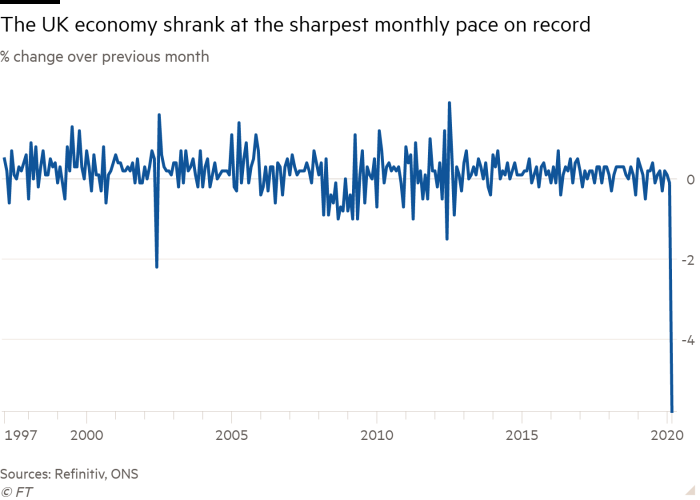UK economy shrinks at record 5.8% pace in March

Roula Khalaf, Editor of the FT, selects her favourite stories in this weekly newsletter.
The UK economy shrank at the fastest monthly pace on record in March as the coronavirus lockdown triggered a crash in activity and demand.
UK gross domestic product fell 5.8 per cent in March compared with the previous month, the largest drop since the monthly series began in 1997, according to first estimates by the Office for National Statistics.
In the first quarter, UK GDP fell 2 per cent compared with the previous quarter, its largest drop since the financial crisis.

Chancellor Rishi Sunak acknowledged the “significant impact” that the virus was having on the economy, telling Sky News on Wednesday that “it is now very likely that the UK is facing a significant recession at the moment and this year”.
Jonathan Athow, deputy national statistician, said: “With the arrival of the pandemic nearly every aspect of the economy was hit in March, dragging growth to a record monthly fall.”
“Services and construction saw record declines on the month with education, car sales and restaurants all falling substantially,” he added.
Output in the services sector, which accounts for 80 per cent of the economy, fell by 1.9 per cent in the first quarter, the largest drop since records began in 1990. The contraction was driven by a 6.2 per cent monthly decline in March and by a sharp fall in travel, accommodation and air transport, whose output nearly halved in March.
Production fell 2.1 per cent in the first quarter, the fourth consecutive quarterly decline, despite pharmaceutical manufacturers reporting increased output. Construction contracted 2.6 per cent — the sharpest fall across all sectors of the economy.
The pandemic also ended more than four years of uninterrupted growth in UK household spending, with the sector reporting a 1.7 per cent fall in the first quarter. Trade was also hit, with a 12 per cent drop in exports and a 5 per cent decline in imports in the first three months of the year.
“The lockdown was only in place for seven working days in the first three months of the year, but it was still enough to bring about the biggest quarterly economic contraction since the peak of the financial crisis and the weakest single-month change on record,” said James Smith, research director at the Resolution Foundation, a think-tank.
“With the country in full or partial lockdown well into the second half of the year, the grim economic milestones hit in the latest data will be shattered next time around,” he warned.

However, the UK economy fared better than that of the eurozone, which contracted 3.8 per cent in the first quarter — reflecting the later start of the British lockdown. In the US, output fell by a smaller 1.2 per cent.
The relative size of the GDP contractions is linked to the stringency of lockdowns, according to the ONS. “When compared internationally, it implies that the size of the contraction in the UK economy in quarter one is broadly in line with what might be expected, given the policies that have been put in place in the UK,” the agency said.
The UK’s quarterly contraction is also milder than the 2.5 per cent expected by economists polled by Reuters, and less severe than the latest Bank of England forecast. Last week the central bank estimated that the economy had shrunk by about 3 per cent in the first quarter and would contract by a further 25 per cent in the second quarter. This would mean an almost 30 per cent drop in the first half of 2020, the fastest and deepest recession for 300 years.
However, the ONS cautioned that economic estimates for March and the first quarter “are subject to more uncertainty than usual as a result of the challenges we faced in collecting the data under the government’s imposed public health restrictions”.
This week the UK government issued a road map for the gradual restart of the economy, but economists doubt there will be a sharp rebound.
“The prospects of a ‘V-shape’ recovery have long since faded, and we don’t expect the size of the UK economy to return to pre-virus levels until at least 2022,” said James Smith, economist at ING.
“It is clear that the landscape for many sectors has changed for the foreseeable future, given social distancing measures are likely here to stay until a vaccine or equivalent medical breakthrough occurs.”
Comments